|
|
|
Sort Order |
|
|
|
Items / Page
|
|
|
|
|
|
|
| Srl | Item |
| 1 |
ID:
171071
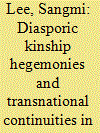

|
|
|
|
|
| Summary/Abstract |
Full Article Figures & data References Citations Metrics Reprints & Permissions PDF
ABSTRACT
Although hegemony has been understood as the property of nation-states and the ruling classes, this paper explores cultural hegemonies among diasporic peoples by examining the pervasive compliance of Hmong living in Laos and the United States with the principles of their kinship system. Since these kinship rules are inculcated through parental education from an early age and are seen as essential for maintaining the cohesion of their dispersed diasporic community in the absence of a territorial ancestral homeland, they have become culturally engrained and taken-for-granted by Hmong through their voluntary consent and no longer have to be enforced by overt power and coercive means. However, like all hegemonies, the Hmong kinship system may also confront increasing challenges and contestation as it is enacted in the different nation-states where Hmong reside, and may eventually become an ideology that needs to be actively enforced and imposed by the direct use of power.
|
|
|
|
|
|
|
|
|
|
|
|
|
|
|
|
| 2 |
ID:
171068
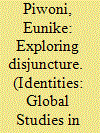

|
|
|
|
|
| Summary/Abstract |
This paper addresses current debates around elites, education and cosmopolitanism. It studies disjuncture (and interaction) between cosmopolitan practices and aspirations on the basis of 24 interviews with international students at a British elite university. Specifically, the article discusses four cases of elite students’ use of cosmopolitanism by drawing on Ann Swidler’s concepts of ‘strategies of action’ and her distinction between ‘unsettled’ and ‘settled’ lives. The case studies demonstrate that individuals, who find themselves in an unsettled phase of their life, may mobilise cosmopolitanism either to set themselves new life goals or to closely examine their lives. In settled lives, cosmopolitanism may be integrated in established strategies of action but it may also be used to (rhetorically) defend a stable orientation. This typology of four different ways of using cosmopolitanism complements previous research by exploring in depth the various forms in which ambivalences of students’ engagements with cosmopolitanism may arise.
|
|
|
|
|
|
|
|
|
|
|
|
|
|
|
|
| 3 |
ID:
171070
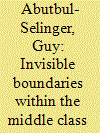

|
|
|
|
|
| Summary/Abstract |
This article explores the integration of ethnic minorities into the middle class in a novel way. Current literature examines the existence of boundaries and the ways they construct ethnic identifications through visible acts. One line of research perceives the middle class as a homogenizing platform that lowers residential segregation and labor market discrimination, while another demonstrates how stereotypes and an occupational glass ceiling continue to operate, reinforcing minorities’ ethnic identifications. By contrast, this article demonstrates the significance of invisible boundaries for the study of ethnicity in the middle class. I center on the ways whereby microaggression, namely tacit everyday insults, signifies an ethnic difference between middle-class adolescents. Analyzing adolescents’ narratives shows how the classification of spaces has given rise in minority adolescents to inner experiences of incongruence and subordination. By constructing an ethnic identity that prevents adolescents perceiving themselves as middle-class subjects, invisible boundaries reinforce the ethno-class order.
|
|
|
|
|
|
|
|
|
|
|
|
|
|
|
|
| 4 |
ID:
171069
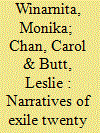

|
|
|
|
|
| Summary/Abstract |
In response to Indonesia’s 1998 riots, which included mass rape of Chinese-Indonesian women, many Chinese-Indonesian families sent their daughters out of country to try and ensure their safety. Drawing on interviews with Chinese-Indonesian women currently living in Singapore and Australia, this article considers the long-term effects on transnational families of this departure. In contrast to current views of Chinese-Indonesians as an affluent diaspora, we show Chinese-Indonesian women’s experience to be that of exile, living outside Indonesia with little possibility of permanent return. We illuminate the subtle and enduring effects of political violence on women’s marital, reproductive, and childrearing practices. Interviews reveal fragmented identities and contingent household formations which enabled family resilience for some but created long-term fissures for the majority. We argue for more critical attention to how gender mutually constitutes experiences of exile, and the long-term impacts of political violence on reproduction and family relations for Chinese-Indonesian women.
|
|
|
|
|
|
|
|
|
|
|
|
|
|
|
|
| 5 |
ID:
171066
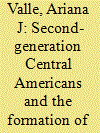

|
|
|
|
|
| Summary/Abstract |
Whether Latinos in the United States are an ethnic or racial group is extensively debated. Some propose Latinos are an ethnic group on their way to becoming white, others contend Latinos are a racialised group, and an alternate perspective posits Latinos are an ethnoracial group. This study intervenes in this debate by examining the identities of second- and 1.5-generation Central Americans in Los Angeles, California. Drawing on 27 in-depth interviews, I show Central Americans have an identity repertoire, which includes national origin, panethnic, racial, and minority identities. I also capture the situations and reference groups that influence the deployment of ethnic and racial identities. These results suggest Central Americans develop an ethnoracial identity. I argue Central Americans’ ethnoracial identity emerges from agency – subjective understandings of themselves and resisting invisibility in Mexican Los Angeles – and from structure – a racialised society, institutionally-created panethnic categories, and racially-based experiences.
|
|
|
|
|
|
|
|
|
|
|
|
|
|
|
|
| 6 |
ID:
171067
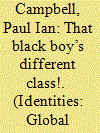

|
|
|
|
|
| Summary/Abstract |
Seldom has leisure as a cultural activity been used to examine the boundary-work and lived realities of black middle-class men in the UK. Drawing on ethnographic data taken from a three-year study of one East-Midlands based African-Caribbean founded football club c.1970-2010, the article addresses these points. It widens existing knowledge on the British black middle-classes in three ways. (1) It indicates that the emergence of the black middle-classes in Leicester is discontinuous, and connected to wider social policies designed to improve the effectiveness of front-line services and pacify urban black youth in the 1980s. (2) Using Lacy’s black Lower and Upper middle-class (BLMC and BUMC) schemata, the paper sketches-out the boundary-work which exist between the club’s black working-class and BLMC and BUMC members, and between the BLMC and BUMC men within the club. (3) That sport possesses its own class-dimensions which further divided black men in Leicester during this period.
|
|
|
|
|
|
|
|
|
|
|
|
|
|
|
|
|
|
|
|
|